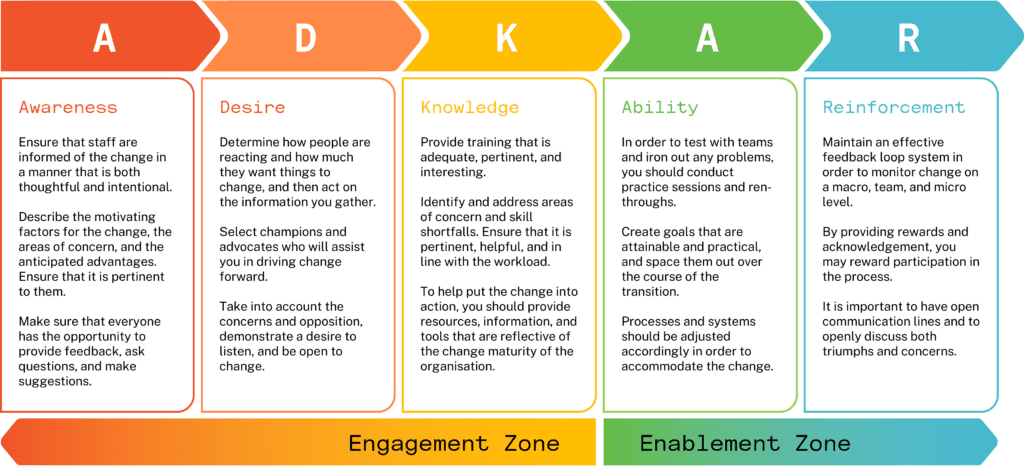In business, change isn’t just inevitable – it’s essential. The organisations that excel are those that skilfully adapt to shifting markets, emerging technologies, and evolving consumer behaviour. However, steering these changes in the right direction can pose substantial challenges. In this article, we provide an overview of the better practice ADKAR model of change management from Prosci, and discuss the challenges and solutions of several of the key approaches in that method.
ADKAR Overview
Prosci is a globally recognised change management firm, renowned for its comprehensive research and innovative tools in the field of organizational change. Founded in 1994, it initially focused on research into change management before evolving into a comprehensive service provider. Prosci’s core offerings encompass training, certification programs, and tools designed to facilitate successful change management within organizations. These offerings target a wide range of professionals, from executives to front-line employees, ensuring a cohesive approach to change.
Central to Prosci’s methodology is the ADKAR model, a framework designed for understanding and managing change at an individual level. ADKAR stands for Awareness, Desire, Knowledge, Ability, and Reinforcement. This model help organisations in diagnosing resistance, helping individuals through change, and achieving successful and lasting change.
Awareness
The change process begins by creating awareness about why change is necessary. This involves understanding the need for change and its potential impact on individuals and the organisation.
Desire
Once awareness is established, it’s essential to cultivate a desire among individuals to participate in and support the change. This phase focuses on motivating individuals by emphasising the benefits and opportunities the change will bring.
Knowledge
Providing the necessary knowledge and information is crucial. Individuals need to understand how to change and what specific actions are required.
Ability
Knowledge needs to translate into action. Individuals must possess the skills and abilities to execute the change successfully. This involves empowering individuals to implement the required changes effectively.
Reinforcement
The final stage is reinforcing the change to make it stick. This step involves providing ongoing support, recognition of successes, and reinforcement of new behaviours to ensure the change becomes a part of the organisational culture.
While Exent leverages standard frameworks such as Prosci’s ADKAR and others, it is important to recognise in the field of human change that there is no single “recipe” for change, that multiple approaches and paradigms need to be tailored for the situational complexities in each engagement, and that a true best practice blends multiple frameworks and tools together with a depth in the psychology and practice of change. Exent has built this framework in an Experience-Led Transformation approach to change, with ADKAR forming a component of some transactional aspects.

Building Desire
While each stage presents its own set of challenges, the Desire and Knowledge phases are particularly tricky to navigate. Let’s look at these two aspects in more detail.
At the heart of the Desire phase is the creation of a strong eagerness among employees to support and actively participate in the change. This critical phase sets the tone for the rest of the change process. Our experience here is that there are the two primary challenges during this phase. We outline these below, including how companies might overcome these.
Employee Resistance
A natural response to change, particularly when it involves altering familiar routines or work processes, is resistance. This often arises from fears of the unknown and in particular with concerns over how the change might affect individual roles. To overcome this, clear communication regarding the purpose of the change, its benefits, and its positive implications for both employees and the organisation is crucial. An open dialogue and reassurance can alleviate fears and foster a desire for change.
Engagement Deficit
When employees have experienced negative changes in the past or lack faith in the leadership team, they may disengage from the process. This lack of engagement can pose a significant obstacle to change implementation. One solution is to involve employees at the outset of the change process. By seeking their input, addressing their concerns, and maintaining transparent communication, you can create an inclusive environment that fosters trust, stimulates interest, and boosts engagement.
Knowledge & Understanding
The Knowledge phase of the ADKAR model is about equipping your employees with the necessary information, skills, and behaviours to implement the change. This phase is vital for the successful execution of the change initiative. Challenges (and solutions) during this phase include the following.
Training and Resource Deficit
Without adequate training or resources, employees may find it difficult to understand the change and how it pertains to their roles. This can hamper their performance and jeopardise the overall success of the change initiative. To counter this, ensure comprehensive training programs are available to educate employees about the change. Also, provide access to all the necessary resources, tools, and support they need to adjust to the new ways of working.
Communication Breakdown
Ineffective communication can lead to confusion, misinformation, and a general lack of understanding during this stage – all of which can disrupt the transition process. To avoid this, ensure clear and consistent communication. Tailor the information to distinct groups based on their roles and involvement in the change.
It is important in our experience to regularly check for understanding and to provide opportunities for employees to ask questions and voice concerns. This two-way communication can help eliminate misunderstandings and ensure everyone is aligned with the change.
Ability to Change
Change management is powerful for enhancing organisational performance and productivity, aligning employees with the company’s goals, and introducing new operational approaches. When employees understand the reasons behind change and its advantages, they adapt faster and engage more in achieving desired outcomes.
This alignment not only boosts productivity but also drives improved business results, enhances efficiency, reduces costs, and creates a competitive edge in the market. To navigate successful change management and to create the tangible ability to change, several key steps are crucial.
1. Articulate Vision and Goals: The initial step involves clearly articulating the vision and objectives behind the change. This means communicating the purpose, benefits, and alignment with broader organisational goals. This shared vision acts as a guiding force, motivating stakeholders throughout the change process.
2. Encourage Employee Participation: Engaging employees in the change process fosters trust, eases concerns, and heightens commitment. Seeking their input, addressing their concerns, and integrating diverse perspectives not only secures buy-in but also uncovers innovative solutions.
3. Offer Comprehensive Training: Training plays a vital role in change adoption. Tailored training programs equip employees with the skills and knowledge needed for a smooth transition, accelerating adaptation to change, and reducing resistance.
4. Measure and Track Progress: Regularly evaluating performance against predefined metrics is essential. This practice offers insights into the change’s impact, allowing for adjustments and the recognition of positive contributions.
5. Foster a Culture of Continuous Improvement: Embracing change as a constant in the business landscape encourages a culture of ongoing enhancement. Encouraging feedback, analysing outcomes, and striving for continual improvement ensures organisational agility and sustained success in evolving markets.
Reinforcing Change
The final stage of the ADKAR model, Reinforcement, often gets overlooked, yet it’s pivotal for long-term success. Sustaining and reinforcing change demands ongoing effort and attention. Here are the common challenges (and solutions) in this stage.
Overcoming Persistent Resistance to Change
Even after initial acceptance, resistance to change can linger. This may stem from employees reverting to old habits or the delayed visibility of change benefits. To address this, continuous communication and support are crucial. To tackle persistent resistance, maintain awareness and desire for change. Regularly communicate its benefits, celebrate short-term wins, and offer ongoing support. Strong leadership presence is vital to inspire and motivate employees.
Ensuring Consistent Communication and Support Post-Implementation
Post-implementation, it’s crucial to maintain consistent communication and support to sustain enthusiasm and adoption rates. Keep communication channels open post-change. Regular updates, reminders, and reinforcement messages embed change into routines. Provide continued support through resources or coaching to reinforce employees’ commitment.
Incorporating Clear Metrics and Accountability
Clear success metrics and accountability are essential for tracking progress and ensuring sustained change. Define success and establish measurable metrics from the outset. Monitor metrics regularly, sharing results transparently. This transparency maintains focus, motivates improvement, and holds everyone accountable. Conduct audits to ensure sustained new behaviours and address any regressions promptly. In addition, conduct regular audits or reviews to ensure that the new behaviours are being maintained and to identify any areas where old habits may be creeping back in. If necessary, take corrective actions promptly to get back on track.
Final Thoughts
Managing change effectively isn’t just strategic; it’s integral to progressive business dynamics. Though challenging, the journey promises enhanced performance, productivity, and long-term success. In Exent’s experience, ADKAR provides a solid foundation – a framework around change strategies, and a toolkit for key change moments – that represent a good, basic approach to change that has endured.
The need is clear – a proactive change management approach that emphasises clear communication, thorough training, and consistent reinforcement – all to support navigating change successfully. To reiterate, change management isn’t one-size-fits-all; it requires a tailored strategy accounting for each organisation’s unique culture, goals, and challenges.



